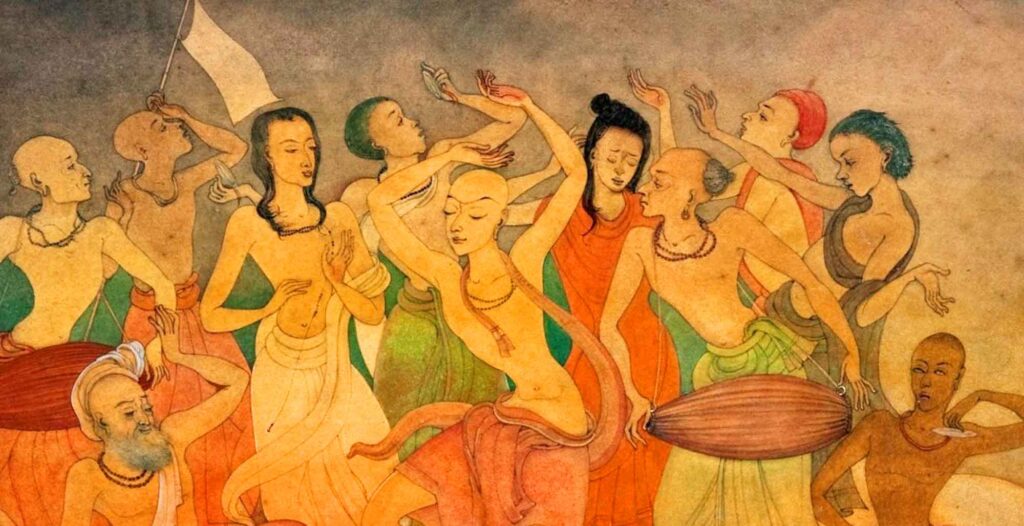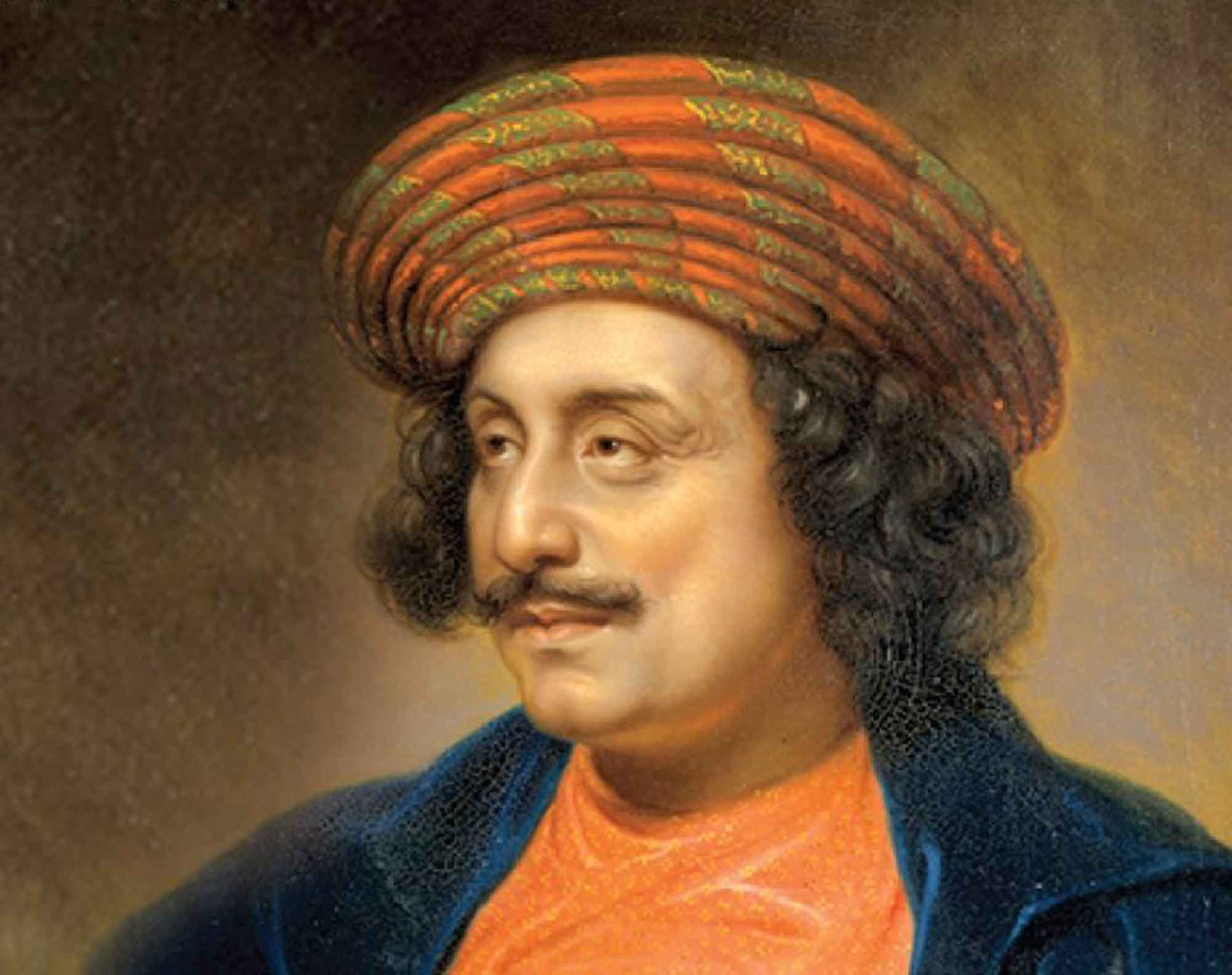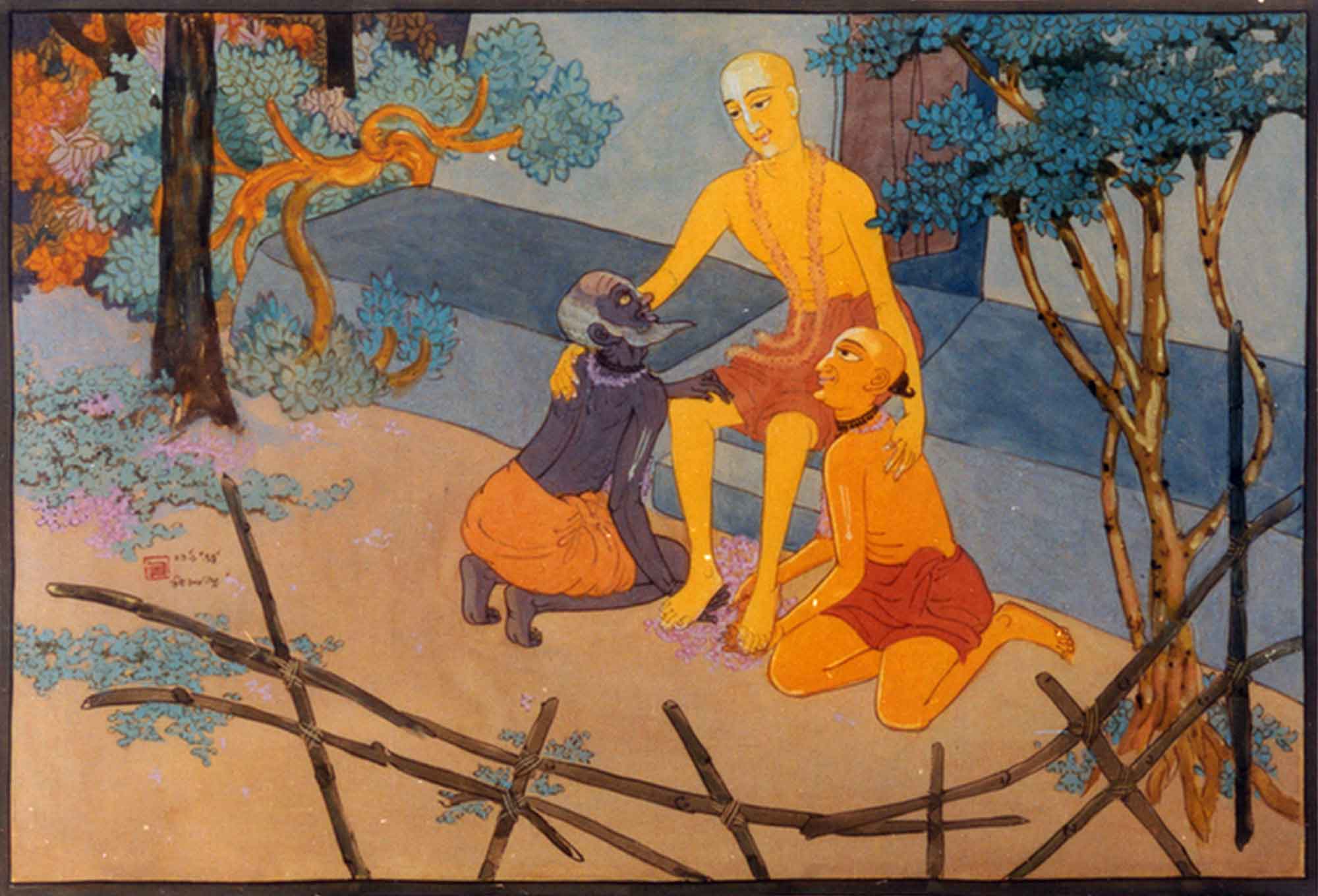Overview
In Māyāvādī Kāhāke Bali? (Who is a Māyāvādī?), published in Sajjana Toṣaṇi, Vol.5, Issue 12 in 1894, Śrīla Bhaktivinoda Thākura explains in detail why māyāvādīs are considered to be offenders to Kṛṣṇa, and why their so-called displays of devotion are useless.
(translated by Swami B.V. Giri)
One who desires to become a pure Vaiṣṇava cannot be like a māyāvādī. Śrīman Mahāprabhu has said:
prabhu kahe, — māyāvādī kṛṣṇe aparādhī
‘brahma’, ‘ātmā’ ‘caitanya’ kahe niravadhi
ataeva tāra mukhe nā āise kṛṣṇa-nāma
kṛṣṇa-nāma, kṛṣṇa-svarūpa duita samāna
nāma, vigraha, svarūpa tina eka-rūpa
tine bheda nāhi, tina cid-ānanda-rūpa
deha-dehīra, nāma-nāmīra kṛṣṇe nāhi bheda
jīvera dharma-nāma-deha-svarūpe vibheda
(“The Lord said – ‘A māyāvādī is an offender to Kṛṣṇa. They simply speak about Brahman, ātmā and caitanya [consciousness]. Therefore his mouth never chants kṛṣṇa–nāma. Kṛṣṇa-nāma and kṛṣṇa-svarūpa [Kṛṣṇa’s form] are both identical. His Name, form and nature – all three are the same. There is no difference between them since they are all inherently spiritually blissful. There is no difference between Kṛṣṇa’s body and Himself or between the name and the Named. The jīva’s nature is that his name and his physical body are different to his spiritual form.’” – Caitanya-caritāmṛta, Madhya-līlā 17.129-132)
ataeva kṛṣṇera nāma, deha, vilāsa
prākṛtendriya-grāhya nahe, haya sva-prakāśa
kṛṣṇa-nāma, kṛṣṇa-guṇa, kṛṣṇa-līlā-vṛnda
kṛṣṇera svarūpa-sama saba cid-ānanda
(“Thus, Kṛṣṇa’s Name, form and pastimes cannot be perceived by the mundane senses – they manifest independently. Kṛṣṇa’s Name, Kṛṣṇa’s qualities and Kṛṣṇa’s pastimes are all equal to the nature of Kṛṣṇa Himself. They are all spiritual and blissful.”– Caitanya-caritāmṛta, Madhya-līlā 17.134-135)
ataeva kṛṣṇa-nāma nā āise tāra mukhe
māyāvādi-gaṇa yāte mahā bahirmukhe
(“Therefore, because kṛṣṇa-nāma does not arise in their mouths, the māyāvādīs are considered to be extremely averse to the Lord.” – Caitanya-caritāmṛta, Madhya-līlā 17.143)
One who is a māyāvādī is inherently an offender to Kṛṣṇa. They will say, “The form of Kṛṣna, the Name of Kṛṣna and the līlā of Kṛṣṇa are all māyika.” The meaning of the word māyika is something amalgamated with māyā, in other words, comprised of the gross elements of māyā. According to the philosophy of the māyāvādis, the śuddha-tattva (pure principle) is nirākāra (formless) and nirviśeṣa (without any attributes). In order to perform activities, that śuddha-tattva takes shelter of māyā and accepts the gross forms of Rāma, Kṛṣṇa etc. The name of this śuddha-tattva is Brahma, Paramātmā or caitanya (consciousness). The forms of Rāma, Kṛṣṇa etc. arise from matter. The Names of Rāma, Kṛṣṇa etc. are inferior mundane sounds. The pastimes of Rāma, Kṛṣṇa etc. are under the sway of māyā. However, the difference between the jīva and Rāma, Kṛṣṇa etc. is that the jīva is forced to attain a gross body due to his misdeeds; but caitanya voluntarily accepts a gross body to perform activities in this world and then gives up that gross body again of his own free will. Thus, the Name, form and qualities of Rāma, Kṛṣṇa etc. are under māyā. Until a sādhaka acquires knowledge, he should worship Rāma, Kṛṣṇa etc. When he gains knowledge, he will only chant Brahma, Paramātmā and caitanya. Then the material form, Name and meditation upon Rāma and Kṛṣṇa is unnecessary.
The māyāvādīs therefore despise the idea that the forms of Rāma or Kṛṣṇa are the śuddha-tattva. This is why the māyāvādīs are offenders to Kṛṣṇa. The kṛṣṇa-nāma that emanates from the mouth of a māyāvādī is not kṛṣṇa-nāma. That is only pratibimba-ābhāsa (a reflection of a semblance) of kṛṣṇa-nāma. Thus, even after chanting, a māyāvādī falls down due to the fault of nāmāparādha.
In fact, what is kṛṣṇa-nāma has been explained. Kṛṣṇa’s Name, Kṛṣṇa’s nature and Kṛṣṇa’s form – all three are one tattva, in other words, they are inherently saccidānanda (comprised of eternity, knowledge and bliss). The expansive effulgence of Kṛṣṇa’s form is the imaginary Brahma that the māyāvādī is searching for. The impersonal words Brahma, ātmā and caitanya are secondary names of Kṛṣna. Paramātmā is an expansion of Kṛṣṇa’s form. Therefore, the problem of the māyāvādī is that he does not know that the śuddha-tattva is actually kṛṣṇa-tattva. The conditioned jīva’s physical form and the jīva who occupies that form are different. The conditioned jīva’s name and his siddha-nāma (name in his perfected form) as a servant of Kṛṣṇa are different; because of this, the siddha–tattva (perfected stage) and māyika-tattva (mundane stage) of the conditioned jīva are mixed. Kṛṣṇa is not like that, and there is no necessity for Kṛṣṇa to be like that. Only through Kṛṣṇa’s cit-śakti can His imperceivable Name, form and personality be perceived by the jīva’s senses. Kṛṣṇa is not under the influence of karma like a jīva, in other words, He is not subordinate to māyā-śakti, or the gross elements of māyā. He performs all His līlā through His yogamāyā. All those līlās have manifest in this material world by His grace through the agency of yogamāyā. That is indeed the identity of His avicintya-śakti (inconceivable potency). Ignorant jīvas like you consider Kṛṣṇa to be devoid of strength and ascribe Him to be working under material energy, to be utterly ignorant of śakti-tattva, who cannot appear in this material world without the aid of the māyā-śakti – this is the siddhānta of the māyāvādīs.
Actually, Kṛṣṇa’s Name, Kṛṣṇa’s form and Kṛṣṇa’s pastimes are eternal self-manifest principles. He is not manifest by any material sun, moon, stars or by the mundane senses such as the eyes or ears. A human’s material senses cannot see the form of Kṛṣṇa and the material tongue cannot chant Kṛṣna’s Name. Everything they see and speak is mundane. Bhakti is an affair which is beyond the mundane senses. The spiritual side of the jīva is His domain. When bhakti becomes strong, the jīva’s eyes, ear, nose and tongue become imbued with His śakti, then the cit-śakti appears to those senses, and one’s spiritual senses manifest. That is when darśana of Kṛṣṇa’s form and the chanting of kṛṣṇa-nāma become the real form and Name. Māyāvādīs are totally bereft of śuddha-bhakti, thus without proper knowledge of Brahman, they only follow a path of worldly jñāna. Therefore, māyāvādīs are constantly averse to Kṛṣṇa and offenders to Him.
It should be understood that any kṛṣṇa-kīrtana etc. that the māyāvādīs perform at the time of sādhana is an aparādha. His kṛṣṇa-kīrtana should not be sanctioned by pure devotees. This is because it is possible to commit nāmāparādha in connection with them. Although a māyāvādī may exhibit tears, horripilation and other types of sāttvika-bhāva during kīrtana, it is not pure. It is only sāttvika-bhāvābhāsa (a semblance of sāttvika-bhāva), and the reflections of such characteristics are particularly offensive. Thus, in the book Śrī Bhakti-rasāmṛta-sindhu we find:
vārāṇasī-nivāsī kaścid ayaṁ vyāharan hareś caritam
yati-goṣṭhyām utpulakaḥ siñcati gaṇḍa-dvayīm asraiḥ
(“When a resident of Vārānasī glorified the character of Hari in an assembly of sannyāsīs, his hairs stood on end and tears fell on both his cheeks.” – Bhakti-rasāmṛta-sindhu 2.3.85)
The sannyāsis residing in Vāranasī are notorious for being māyāvādīs.They are not the only māyāvādis – in their opinion, all the householders that are pañcopāsakas are also māyāvādīs.* Those that have accepted the philosophy of the māyāvādīs are māyāvādīs. Even if one has been initiated with a Vaiṣṇava mantra, if one accepts this philosophy, he is to be known as a māyāvādī. After all, there are many māyāvādīs among those who identify themselves as being connected to Mahāprabhu Caitanyadeva. Many of the beliefs of the Bāulas and Daraveśa are māyāvāda.
*Translators Note: Pañcopāsakas are those who daily worship Viṣṇu, Śiva, Sūrya, Gaṇeśa and Durgā as different forms of Brahman.
Many people affected by the fault of nāmābhāsa are māyāvādīs. Amongst those persons, those that are māyāvādīs are offenders. Those who do not know philosophy, yet have no śāstrīya-śraddhā (śraddhā in the śāstra) and have been initiated into a viṣṇu-mantra, are chāyā-nāmābhāsīs (those who chant a shadow of the semblance of the Holy Name). A chāyā-nāmābhāsī should be understood to be a kaniṣṭha Vaiṣṇava. However, until bhāva for Bhagavān, without any tinge of māyā, is found, he cannot be designated as a pure Vaiṣṇava. The madhyama-adhikārīs and uttama-adhikārīs are pure Vaiṣṇavas. The kaniṣṭha-adhikārīs are chāyā-nāmābhāsīs. They too also become madhyama-adhikārīs through sādhu-saṅga.
A māyāvādī is a pratibimba-nāmābhāsī (one who chants a reflection of the semblance of the Holy Name), therefore he is an aparādhī. It is extremely difficult for them to become pure Vaiṣṇavas. No matter how many displays of sāttvika-bhāva they show, they cannot be called Vaiṣṇavas.
One should know that the most excellent, transcendental cit-śakti, the nature of Bhagavān, His form and His Name are one akhaṇḍa-tattva (indivisible truth), and one who believes in this principle, has brotherly affection for the Vaiṣṇavas, and has śraddhā in Vaiṣnava dharma, his śraddhā is called śāstrīya-śraddhā. One who does not have such śraddhā, even if he is not contaminated by māyāvāda, cannot attain the designation of a ‘pure Vaiṣṇava.’ One who follows the māyāvāda philosophy is avaiṣṇava. The aṣta-sāttvika-vikāra of a māyāvādī is totally useless.* For the pure Vaiṣṇavas, if the eyes are even a little moist from chanting kṛṣṇa-nāma, that is desirable.
*Translators Note: The aṣta-sāttvika-vikāra (eight ecstatic bodily transformations) are stambha (paralysis), sveda (perspiration), romāñca (horripulation), svara-bhaṅga (faltering of the voice) kampa (shivering), vaivarṇa (change of bodily hue), aśru (tears) pralaya (fainting due to devastation).
We have written about this subject very clearly since there are many things going on these days. It is not the duty of Vaiṣṇavas to practice this, therefore we are not engaging in any gossip. I have discussed this much only in order to keep the pure Vaiṣṇavas strong in their position.













